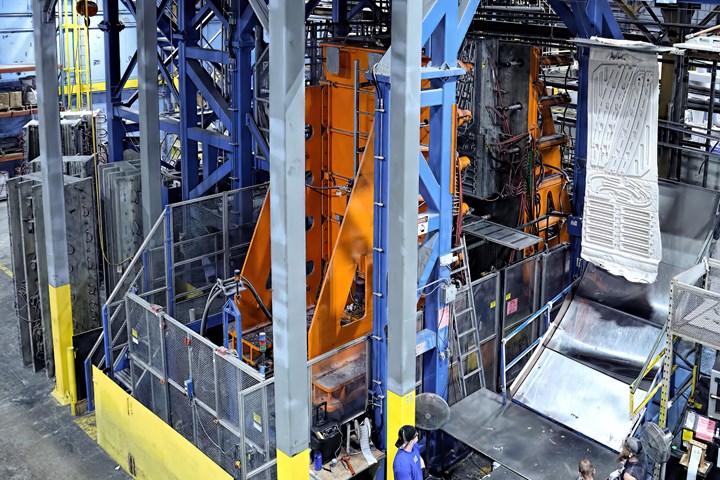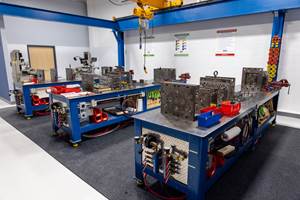Teaching Kids About the ‘Magic’ of Manufacturing
Making something out of (almost) nothing is an ‘eye opener’ for youngsters in their first exposure to plastics processing.

How does a bunch of plastic pellets get transformed into a product such as a swimming-pool ladder? That’s the practical “magic” of manufacturing that engages young people who visit Confer Plastics’ blow molding plant for the first time. (Photo: Confer Plastics)
Something struck me while I was interviewing the head of a blow molding company for the upcoming On-Site feature in the April issue of Plastics Technology. Bob Confer, president of family owned Confer Plastics in North Tonawanda, N.Y., was telling me about the perennial shortage of available labor, made worse by declining school enrollments in New York State. Confer Plastics, he said, was lucky in having nearly a quarter of its employees in the “20-year club” – indicating their lengthy tenure at the company. But Confer Plastics still has the challenge of finding new employees to make up for attrition and support growth (the company has added its 20th accumulator-head machine).
To attract young people to jobs at Confer Plastics, as part of the firm’s community outreach program, the company sponsors open houses and offers internships and “shadowing” programs through which high-school juniors and seniors spend a day with an employee to learn about manufacturing careers. The company welcomes visitors from community organizations and students from local high schools, elementary schools and colleges. “It’s an eye-opener for them,” Bob Confer says, “to see tiny beads of plastic transformed into all these parts.”
That last bit made me stop and think. I’ve heard other molders tell me how they hoped a profusion of glowing touchscreens throughout their plants would convince today’s smartphone-dependent teenagers that “this isn’t your grandfather’s sooty old factory.”
I had nodded approvingly at such remarks in past interviews. But Bob Confer’s comment showed me a new angle on the matter. There might be something less than optimal about hiring kids who look forward to poking touchscreens or keyboards all day long, if they don’t have a real feeling and a real concern for what’s physically happening inside the machine that is reflected in those blinking screens.
How much more valuable might those new recruits be if they were captivated by the amazing transformation of a bunch of homely pellets – or “nurdles” as they are called on Confer’s – into useful, enjoyable products such as kayaks, swimming-pool ladders and hot-tub enclosure panels. So captivated that they wanted to know more about how that happens, what about the pliant nature of plastics and the electric, hydraulic and mechanical forces in the machinery makes it all possible.
When, fresh out of school, I joined the staff of Plastics Technology, I was motivated by a hunger to see how things really work, to learn what goes on “behind the scenes,” so to speak, to put all those cars on the road, packages of food on store shelves, and innumerable useful objects in every room of my home. That’s the kind of eagerness for knowing and participating in the real world of making things that we should encourage in today’s generation that’s so absorbed in apps and e-this and e-that as substitutes for physical interaction with people and their environment. Success in that effort would be good for young people, good for society and good for plastics.
Related Content
Paulson Training Acquired
Certus, a technical skills training ┤¾¤¾┤½├¢ and portfolio company of private equity firm Ridgemont Equity Partners, has acquired the plastics processing training ┤¾¤¾┤½├¢ founded in 1981.
Read MoreBoise State Team Wins Circular Plastics Challenge Focused On PET Recovery
NPE2024: The competition is a collaboration between Hillenbrand, Net Impact and Coca Cola.
Read MoreThe Cost of High Employee Turnover in Injection Molding: Why Retention Matters
Starting in molding in 1993 and clocking in for nearly every job on the floor over the intervening decades, I’ve seen all sides of the hiring, training and retention process in the industry. Here are my thoughts on how to keep your most important asset — your people.
Read MoreAmerican Injection Molding Institute Opens Mold Maintenance Classroom
The Beaumont subsidiary has opened the Mold Maintenance Center of Excellence classroom at its Erie, Pennsylvania, headquarters.
Read MoreRead Next
Beyond Prototypes: 8 Ways the Plastics Industry Is Using 3D Printing
Plastics processors are finding applications for 3D printing around the plant and across the supply chain. Here are 8 examples to look for at NPE2024.
Read MoreFor PLASTICS' CEO Seaholm, NPE to Shine Light on Sustainability Successes
With advocacy, communication and sustainability as three main pillars, Seaholm leads a trade association to NPE that ‘is more active today than we have ever been.’
Read MoreMaking the Circular Economy a Reality
Driven by brand owner demands and new worldwide legislation, the entire supply chain is working toward the shift to circularity, with some evidence the circular economy has already begun.
Read More













